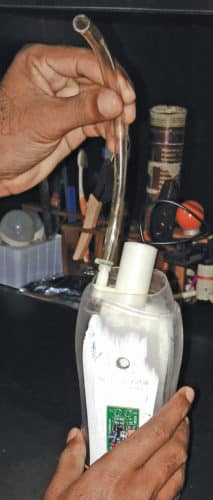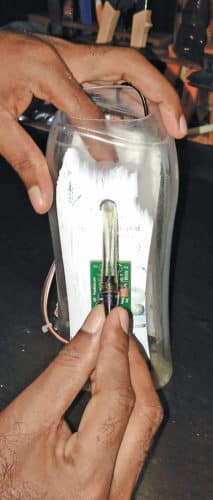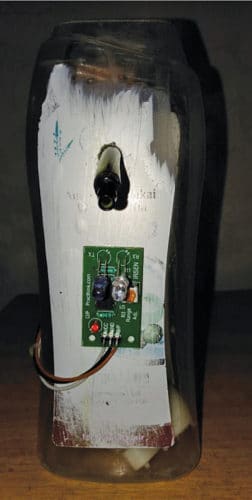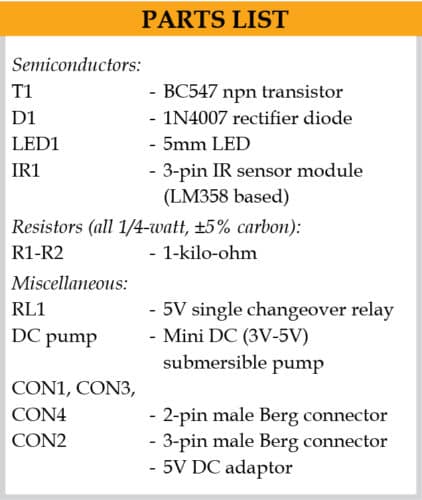 This project is based on an infrared (IR) sensor, which detects the presence of hands and consequently activates the motor pump to dispense alcohol-based sanitiser. The circuit is economical, reliable, and can be easily constructed, as explained below.
This project is based on an infrared (IR) sensor, which detects the presence of hands and consequently activates the motor pump to dispense alcohol-based sanitiser. The circuit is economical, reliable, and can be easily constructed, as explained below.
Circuit and working
The block diagram of IR based automatic hand sanitiser dispenser is shown in Fig. 1, and its circuit diagram is shown in Fig. 2. It consists of an IR sensor module (IR1), transistor BC547 (T1), 5V single-changeover relay (RL1), diode 1N4007(D1), LED1, mini submersible DC motor pump, and a few other components.

Note that there are two types of IR modules commonly available in the market. One is based on LM393, whose output goes low when an object is detected, and another is based on LM358, whose output goes high when an object is detected. This project uses a 3-pin IR module based on LM358.

The project uses 5V DC to drive the circuit. When the IR sensor detects a hand, its output goes high. This high output drives relay driver transistor (BC547) and energises relay RL1. Submersible DC pump gets power supply through NO contacts of the relay. This turns on the DC pump, and hand sanitiser liquid starts to flow out of the small plastic pipe fitted on the bottle.
When there is no hand or object in front of the IR sensor, its output goes low. This low output cuts off relay driver transistor (BC547) and de-energises relay. When the submersible pump disconnects from the power supply, the DC pump goes off, which stops the flow of hand sanitiser.
Construction and testing
You can use a 5V DC adaptor to operate the circuit. Assemble the circuit on a general-purpose PCB and enclose it in a suitable cabinet. Attach the IR sensor module on the front of the dispenser bottle. The proposed construction details are explained here:
- The author has used a shampoo bottle for this project. First, connect various components used in the project, as shown in Fig. 3.

Fig. 3: Various components used in the project - Trim shampoo bottle at a suitable length. Insert DC pump and small plastic pipe (20-30cm) inside the bottle, as shown in Fig. 4.

Fig. 4: Insert DC pump and pipe inside the bottle - Make a small hole on the bottle so that one end of the plastic pipe can be fitted on the bottle, as shown in Fig. 5.

Fig. 5: Fitting the plastic pipe on the bottle - Attach the remaining components, including the main circuit and IR module, on the bottle using glue. Pour down sanitiser into the bottle and cover it with an airtight lid. The final proposed assembly is shown in Fig. 6.

Fig. 6: Final proposed assembly of hand sanitiser dispenser
Switch on the circuit and keep your hands in front of the IR sensor module. Sanitiser fluid will flow out and continue to flow out until your hands are withdrawn from the sensor.
You need to cover the IR module with suitable insulation and water-proof material so that it would not get damaged in case liquid falls on the module. The IR sensor detects hand at a distance in the range between 2~30cm. You can manually calibrate the sensitivity using an inbuilt potentiometer on the IR module.

Note
The IR module tends to get activated by itself when kept in open sunlight and sometimes even under tubelight inside a room. It is recommended to use a suitable contraption or enclosure for the IR module to prevent false triggering by ambient light.
Rameshwer Prasad Nishad is an electronics hobbyist.








i am studying b.tech final year can u share me documentation of ir based automatic hand sanitiser,it so help for me
Hi Daruru, you can save the webpage as a PDF on your browser.